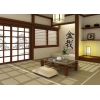|
 Minimalism, a modern trend in interior design, most likely
emerged in Japan. A traditional Japanese home features very few furniture
items and a lot of space. In the East, and Japan in particular, it is common to focus on the
inward man and his feelings, therefore Japanese interior is so
minimalistic. Nothing should distract a man from contemplation
of excellent beauty in ordinary things; thus, Japanese
aesthetics considers excessive details to be ugly. Empty space emphasizes
the refinement of few objects in the room, and they are only
the most necessary articles of furniture, daily life and decor. All things
and domestic utensils are hidden in closets and build-in wardrobes. Minimalism, a modern trend in interior design, most likely
emerged in Japan. A traditional Japanese home features very few furniture
items and a lot of space. In the East, and Japan in particular, it is common to focus on the
inward man and his feelings, therefore Japanese interior is so
minimalistic. Nothing should distract a man from contemplation
of excellent beauty in ordinary things; thus, Japanese
aesthetics considers excessive details to be ugly. Empty space emphasizes
the refinement of few objects in the room, and they are only
the most necessary articles of furniture, daily life and decor. All things
and domestic utensils are hidden in closets and build-in wardrobes.
Besides, a traditional Japanese house does not have walls, and a landscape
is a natural extension of an interior. A house inside is not
divided into rooms, but into functional zones, which have recently become
very popular. Stylish screens, each of them being a piece of artwork,
function as temporary dividers. The advantage of screens in this interior
is irrefutable, they make the space light and transparent, and transposing
them is an easy way to constantly renew the interior, to redecorate
it, and make new accents if necessary.
Japanese culture draws more and more attention of modern megacity
residents, who are attracted by original and centuries-old traditions
tightly intertwined with the latest achievements of progress. And Japanese
interior features stylish simplicity and uncommon solutions to the
customary design tasks. This might be the reason for such popularity of
Japanese style in the personal space, where it is sufficient to
use only several details to bring some associations with the country of
the Rising Sun.
Japanese minimalism rests in harmony with nature and natural beauty, which
are philosophical essentials of Japanese dwelling. Therefore entire
Japanese interior is filled with warm and calm colors, and furniture and objects
of decor are made from natural materials, such as bamboo, straw,
uneven brick and rice paper. Regular doors are to be replaced
with extensible ones, and the floor has to be natural.
A very special effect can be achieved by combining dark
wood for elements of decor with golden shades of natural
furniture, sandy or lusterless tones of walls and color of dried
grasses for the floor. It gives a striking sensation of proximity to nature, as
if you happen to be in the autumn garden without leaving your apartment.
Besides the screens, functional zones in the house can be
distinguished with drops in the level of the floor and bamboo curtains.
There should be very few objects of furniture, but they must be elegant
and richly decorated with fancy accessories. A comfortable varnished
coffee table is well-becoming in the middle of the room, and can be used
both for decoration purposes and tea ceremonies. Floor mats and light
screens contribute to the creating of light space. And a niche in the
wall will emphasize laconicism and beauty of the floor and ceiling. It can
accommodate a stylish wooden box or a statuette, or it can be decorated
with exquisite ikebana (flower arrangement).
A struggle to preserve naturalness has brought objects of furniture with
diverse natural surface textures into contemporary interiors.
Furniture is mainly lusterless, thus, specks of light do not
destroy the harmony of soft illumination. Indeed, the light plays a special
role in the Japanese dwelling, and illumination here resembles the
moon, but not the sun. Room never sinks in the darkness, and soft light of
lamps only accentuates rare items of interior, emphasizing their
uniqueness and significance, creating the game of light and shadow. Scattered
light evokes the sensation of changeability, akin to the Japanese perception of
the world.
Dwarfish trees (bonsai) are a bound attribute of Japanese interior,
they introduce unique Eastern flavor just by their presence. Scrolls
(kakemono), lamps and elegant porcelain will change the interior even
more, bringing it closer to a Japanese one.
The house, designed within the laws of Japanese interior, indicates the
wisdom of its owners and shows their immunity to the fuss of the external
world. But this style is not for everyone: people, who love splendid
parties and noisy, stormy life, will not appreciate a house, which is full of
empty space, air and light.
However it must be told, that creation of interior in Japanese style does not
have to be a strict quotation of the Japanese dwelling, a hint toward the
Eastern culture is sufficient to bring a stream of fresh
air into European houses.
|